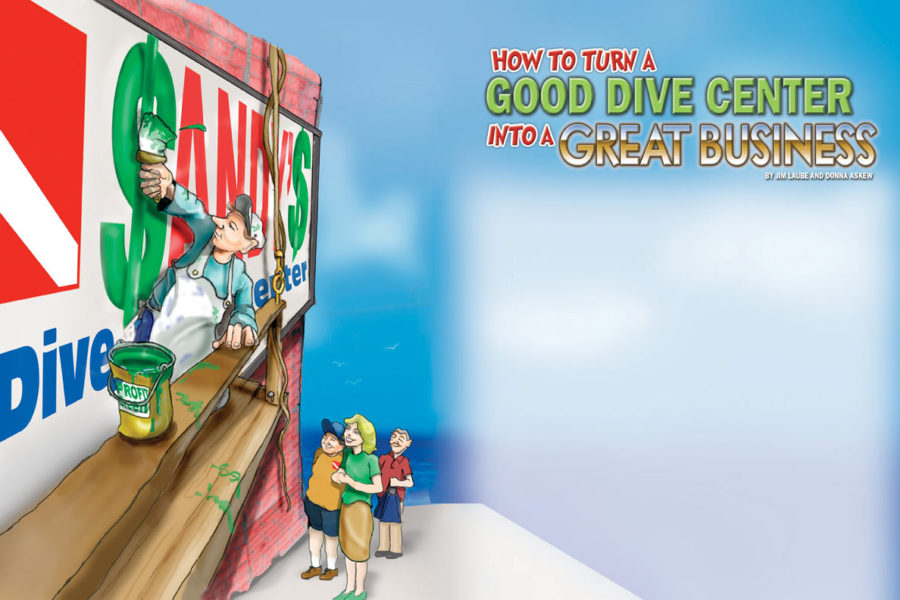
Expenses that can generate income are good employees, advertising that works, the store van, your Web site, even the rent. Yes, you pay for them from the same checkbook, and yes, they show up on the profit-and-loss (P&L) statement below the income lines. But what if you treated them as if they were above the expense lines? Certain expenses, if perceived and directed properly, managed and not bean-counted, can be employed as strong sources of income.
My brother worked for car dealers for many years. He started in the credit department and worked his way up to running a number of fairly large dealerships. After two decades of doing that, and disillusioned with the people he worked for, he struck out on his own. Doug’s company collects receivables for auto dealers. Believe it or not, quite a few car buyers bounce deposit checks and dealers don’t have leverage to collect them when banks or finance companies hold the contracts, and thus the titles to the cars. People also bounce checks in the service, parts and other departments. The large number of deadbeats and the dealers’ lack of will and energy to pursue them can provide a substantial income for my brother. He ran the numbers for me one night. His business has the potential to make hundreds of thousands of dollars annually through commissions, court service charges and lien fees. It’s a business with no cost of goods, just the expertise, effort and energy that it takes to do that kind of work. Yet my brother has been at it for six years and is nowhere near the potential that he knows the business has. Nor does it seem to be fun or fulfilling, as he puts in 60-80 hours a week, mostly doing parts of the business he doesn’t really like. He seems to be always buried and chasing his tail. It’s pretty clear, I think even to him, that for the business to work he needs a good employee or two. Maybe a younger guy or girl with energy and drive who sees the potential of working for a good percentage of their own collection revenues. A strong employee would pretty quickly pay his own way, could make a lot of money, and become his own profit center for my brother. More important, it would allow Doug to be far more productive. He could work on getting more business by developing a larger dealer base, and concentrate on dealer relations. That’s what he likes to do. Then who knows? He could add another good employee or two to duplicate or triplicate the success. All it takes is one strong hire, and he’s on the way.
Or he doesn’t have to hire anybody and keep going on the way he is. In fact, over the years he has had three employees. They were burnout buddies from his dealer days that he didn’t have to pay much, and you guessed it, they didn’t do much. Because of that experience I believe that he sees employees as an expense, which I guess they are when you hire anchors instead of engines.
There are expenses in your business that should not be seen as expenses because they have the potential to produce income that far exceeds their cost. To view them mainly as expenses leads to treating them as costs to be managed, which practically ensures that they will be mediocre in generating income.
Certainly there are expenses that look and act like expenses — lights, taxes, stationery, gas; they should not be confused with expenses that can generate income. Expenses that can generate income are good employees, advertising that works, the store van, your Web site, even the rent. Yes, you pay for them from the same checkbook, and yes, they show up on the profit-and-loss (P&L) statement below the income lines. But what if you treated them as if they were above the expense lines? Certain expenses, if perceived and directed properly, managed and not bean-counted, can be employed as strong sources of income.
Moving Advertising Above the Line
Retail advertising should be handled not as an expense, but as an investment. Some stores confuse retail advertising with institutional advertising. Although all advertising is aimed to sell something, institutional advertising is more what your manufacturers do for a number of other reasons, including branding consumers, reinforcing a position with their dealers, positioning themselves in the industry and supporting your sales efforts. Retail advertising on the other hand should be invested and managed to immediately increase business. At the very least, the business that is generated from any advertising effort should cover the advertising’s cost, and if that’s all it does the referrals and additional business from those customers will almost certainly follow. That’s the profit from the advertising.
There are two problems with retail advertising. First, most of it doesn’t work, and that turns retailers off of advertising in general. But some does work, and that’s the other problem. Most stores don’t realize what works, so they can’t distinguish what works from the marketing efforts that don’t. That’s why, in many stores, all advertising eventually goes away. There’s a key to deriving income from retail advertising. It has to be tracked. That’s really pretty simple because all it requires is to ask every customer that you don’t already know, ‘Do you mind if I ask how you found out about us? ‘Ask that question to everyone new that calls in and walks in the door, and record the answers.
Why do so few stores do it? It requires a change in your store’s routine. It requires a buy-in from everyone who works there and it has to become part of your mandate — ask the question and record the answer. You should do it even if you’re not advertising much. People will tell you that they came in from your telephone book ad, or they saw your van driving around or were referred. It’s knowing that will tell you how well those things work, and at some point will help you realize that there are other things you might be or should be doing. You can design a simple system to record the answers. Keep it at the front counter. When someone calls or walks in to inquire about lessons, at some point in the conversation you’ll ask the question, Can I ask how you found out about us? and when they answer put in the person’s name under the source, e.g., Groupon®.
When someone walks in it doesn’t mean that the store itself is the source. You still have to ask because people who walk in might be referred or maybe they came in from your newspaper ad. Again, the key is to always ask the question and record the answer in the appropriate place. Your tally sheet can be set up for a week or month, and you should keep a master sheet that accumulates lead source information. This provides both short- and long-term analysis. At the end of the year when your Yellow Pages rep calls you’ll know if the larger ad was worthwhile. This is especially useful when you start a campaign. You can track it instantly as it happens. No more guessing and no more asking what your gut feels. With a tracking system in place, the key then is to continue or expand things that work, eliminate the things that don’t, and try and monitor new things. Only advertising that doesn’t work is an expense. Advertising that works is an investment.
Moving the Store’s Van Above the Line
Many stores have utility vans that they use to haul gear and people. As an expense, it’s a great write-off, but if your van is driving around with the original paint and no lettering, an expense is all it is. It can be a good source of income as a rolling billboard. It might, in fact, become among the best advertising that you do. A well-designed and lettered van will be seen all over town, by thousands of people each day or each week, and can bring in lots of new customers. And when you consider your van to be a source of income, it won’t sit hidden behind the store. You will always park it by the main entrance, or where it’s visible to the main flow of street traffic to give your store even more visibility.
All that is true, so if you don’t have a store van, it is well worth the expense (income) to have one, and to get it professionally lettered. By the way, you’ll know how well it is working to generate customers because remember? You’ve already decided that marketing is above the expense line, and you are tracking where your business is coming from. By the way, there are some great-looking dive store vans in this industry. The people who own them know that they are a good source of income. Some of the vans we’ve seen carry statements like these: LEARN TO DIVE TODAY. CHANGE THE WAY YOU SEE THE WORLD FOREVER WWW___________COM WE KNOW YOU HAVE ALWAYS WANTED TO LEARN TO DIVE WWW___________COM SCUBA DIVING CHANGES LIVES! ASK US HOW WWW___________COM GET UP CLOSE AND PERSONAL WITH NATURE AT ITS BEST — LEARN TO DIVE WWW___________COM IT’S SPECTACULAR DOWN BELOW WWW___________COM WANT TO SEE HOW THE OTHER 75% OF THE EARTH LIVES? WE CAN TAKE YOU THERE. LEARN TO DIVE TODAY. WWW___________COM.
Moving Rent Above the Line
Obviously your store produces income in visibility to the public, and as the place where customers come to learn to dive, hang out, get air and buy gear. There is no question it generates income, so why mention it here? Let’s overstate what’s obvious. A store that is well-lit, well-displayed, neat, clean and feels comfortable will do more business than a store that is poorly lit, cluttered, disorganized and dirty. That being true, the closer you are to a really inviting store the more professional you will appear, the more people will come in, the more people will stay in, and the more business you will do.
The store is the place where you go to work each day. You become so involved in running all parts of the business that the store itself becomes background. You may no longer see it the way your customers do, or even take the time to look for ways to make the store more inviting or more oriented to sales. Mannequins, aquariums, posters, signage, ocean-theme displays, a fresh coat of paint or new carpeting — there are always things you can do to brighten the appeal of your store. If you see it as an income producer, your store should always be a work in progress. If you are at a loss for ideas, talk to your representatives about things that they see in other stores. Ask the reps you trust for an honest appraisal of your store, and ask what they would improve if they owned your store based on other stores they see. Then peruse the Web sites of other dive centers around the country. Always consider ways for your store to produce more income. For additional ideas, see the article, The Sales-Friendly Environment: Improving Sales Through Visual Merchandising.
Moving the Phone Above the Line
Your phone can be a huge source of income. Not the phone itself, but the way it’s handled; especially when someone calls to inquire about diving. Countless businesses, not just in dive, do a crummy job of fielding inquiries. The store people come off as tired and uninspired and use the same rote pitch that the last caller heard. Every sale begins from a first impression, so handling the phone poorly is business suicide. A lot of people call to inquire about diving and some become your customer. If you do a poor job handling their initial contacts you’ll convert a few of them; if you can do a perfect job you’ll have almost all of them.
Think of the phone as an income producer. What is the difference to your store’s revenue between turning 2 out of every 10 inquiries into students, or all of them? Four or five times more? For simply being very good on the phone? There is a lot you can do to increase business with proper phone etiquette and sales techniques, and that is the subject of the article Hold the Phone: Dialing for Profit with Professional Telephone Techniques
Moving Your Web Site Above the Line
What is the main value of a Web site to a dive retailer? Even though the Web has worldwide reach, surprisingly, it’s the ability to reach out locally and sell people in your community on diving. Need convincing? We talked earlier about the store van. Picture your van as it drives around town, or is parked in a prominent streetside location of your parking lot. The message on the van reads Learn to Dive With Us at WWW.Divestore1.com. Hundreds, maybe thousands of people see it every day. How many people who have always thought about learning to dive will jot down the Web address and look you up? Despite what people believe about the power of search engines, most of the traffic to most of the sites comes from something else. A Web site is an important way for customers to respond to your marketing efforts, and they’re coming in from your newspaper ads, your van and business cards, brochures, billboards, store literature, and your store’s after-hours phone message. It’s important to know that.
The Web allows people to address their curiosity on their terms, and allows you to sell them before there is any contact whatsoever. Thinking of your Web site as a source of income doesn’t mean selling gear. It means getting prospects interested in diving and wanting to learn with you — producing customers for income. Your site has to be part of your total marketing mix. If you think of all your marketing efforts as interdependent, such as the store van earlier in this article, you will find ways to make all your efforts work harder. A Web site should be more than an electronic billboard where you talk about how great your store is. Consider the way local people will use it. Make your Web site a resource center about diving. Think of it from their perspectives, not from yours. Be generous with what you know — make up fact sheets or frequently asked questions (FAQs) about diving. Post your class and trip schedules. Make diving look fun and use photos from trips and testimonials from customers. Give interesting descriptions of the history of local wrecks and photos of local marine life. Think about how you could create compelling descriptions of local dive sites to get your customers in the water.
Even some of the best store showrooms and pool areas are tough to photograph, mainly because of the lighting. Consider hiring a professional photographer to do it right. It’s a small expense considering the value to your Web site and promotional materials.
Moving Employees Above the Line
Employees are both the biggest expense to a business and the greatest potential source of revenue. Consider my brother. We did some math that showed an effective employee might earn commissions of $80,000 and still put $100,000 to Doug’s bottom line. And that doesn’t consider how the person would free my brother to generate more income. Is that an expensive employee? No, what he hired were expensive employees. They did just enough to cover their cost, didn’t ever contribute ideas, and, worse, they were a mental drag.
A business is a very different place when it has very good employees, but there are a number of issues regarding employees in a dive store. First, dive stores have all different structures. Some stores are pretty much solo acts; it’s the owner and maybe an independent instructor. Many stores have a full staff including store managers, salespeople, repair technicians, travel specialists and instructors. And there is every structure in between. Discussing employees is a touchy subject because they are people, not fixtures, and decisions about hiring, firing and pay levels are always personal. It seems to be generally believed that a typical dive store can’t pay well enough to attract and/or retain really good people. I would pose the argument that a store can’t afford not to. What would the difference be in your store’s income between an employee who can turn 2 out of every 10 inquiries into students, or one who can consistently get seven to sign up. How many more equipment packages might you sell because a strong employee knows how to relate to customers and knows how to sell? Then consider the real value of someone with energy and ideas, and how much more you as an owner or manager could accomplish if you weren’t doing the job of three other people. In a choice between two candidates for a job, the good one that is asking for $15,000 more could make up that pay difference, probably in spades. Good employees are one of your largest sources of income. Marginal or poor employees are your largest expense. It goes beyond having the right people in place.
The other issue in the employees as income or expense debate has to do with guidance and training. Everyone, even your independent instructors, have to be trained to represent your store well and be effective in customer relations and sales. Even the best employees will fall short of their potential without the right guidance, training, product knowledge and encouragement. It takes time, attention and effort on your part, but as an owner or manager you’ll have more time to devote to important stuff like training and guidance when you have good, well-trained employees doing the work.
Final Thoughts
None of this is something you don’t already know, but have you ever considered what could happen to your business if you could pay the caliber of a store manager who is in the $70,000 salary range? Have you ever done the math on the income that might produce? Have you calculated the customers who never come in because you don’t have the right marketing in place, or the ones who get away because you don’t have the right people to handle them?
The difference between a store that does well and one that struggles is not found in the store’s expenses. It is generally that they are treated as expenses. When Marketing is Not an Expense Here’s an example of marketing as an investment. You find a local mail list company and describe your average customer. They sell you a list of the residents in your local area who fit the profile. You mail a learn-to-dive or intro-to-scuba piece with a good sales presentation and a great offer and over the next few weeks 20 people inquire from the mailing, and three couples sign up. You know this because lead tracking in your store is as mandatory as breathing. The mail list and the mailing itself cost you $650. Between the class fees and basic gear purchases you made $2,500. You know some of the students will buy hard goods and will have a greater lifetime value. And they will refer some friends. That $650 for advertising was not an expense. You treated it as an investment and because you know the result you will want to repeat the same effort in other neighboring areas.
The key to making advertising an investment is to try something, track it, drop what doesn’t work and repeat what does. Sounds simple, but most retailers, and not just in this industry, don’t do this.





